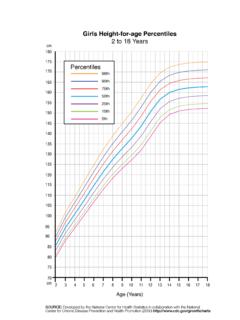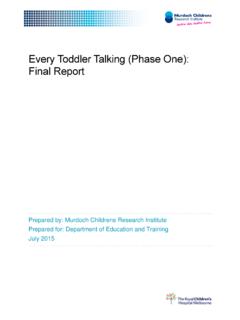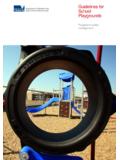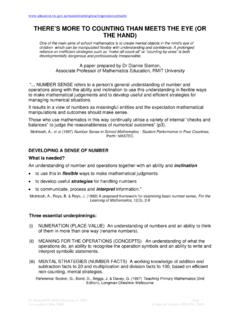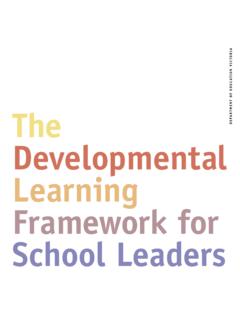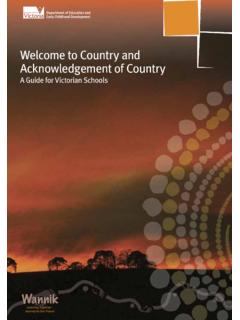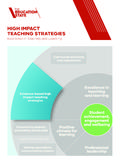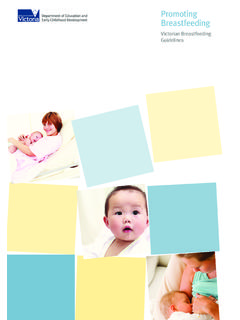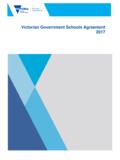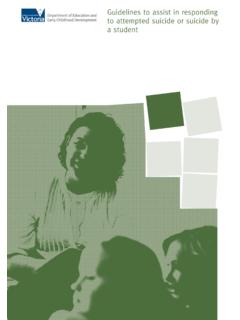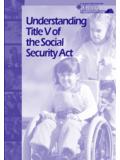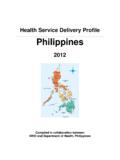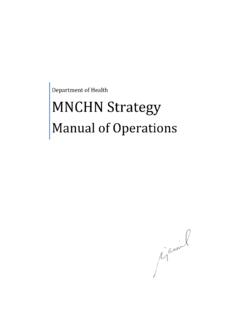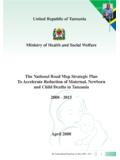Transcription of Identifying and Responding to All Forms of Abuse in Early ...
1 Identifying and Responding to All Forms of Abuse in Early Childhood Services2 PROTECT Identifying and Responding to All Forms of Abuse in Early Childhood ServicesDET 2016 Table of ContentsIntroduction 4 Understanding Your Obligations 6 Duty of Care Obligations 7 Criminal Offences 7 Mandatory Reporting 8 Child Safe Standards 8 National Quality Framework (Approved Services) 9 Victorian Children s Services Act 1996 (Licensed Services) 11 Maternal Child Health Program Standards, Guidelines and By-Laws 11 (Maternal Child Health Nurses) Identifying Signs of Child Abuse 12 Physical Child Abuse 13 Child Sexual Abuse 15 Grooming 18 Emotional Child Abuse 20 Neglect 21 Family Violence 23 Children Exhibiting Inappropriate Sexual Behaviour 25 Four Critical Actions.
2 Responding to Incidents, 27 Disclosures or Suspicions of Child AbuseYou MUST Act 28 Document your Actions 28 Witnessing an Incident 30 Forming a Suspicion 30 Receiving a Disclosure 30 Forming a Reasonable Belief 30 Strategies for Managing a Disclosure 313 PROTECT Identifying and Responding to All Forms of Abuse in Early Childhood ServicesDET 2016 One: Responding to an Emergency 32 Two: Reporting to Authorities 34 Three: Contacting Parents/Carers 37 Four: Providing Ongoing Support 39 Responding to Concerns About the Wellbeing of a Child 44 When to Report Wellbeing Concerns to Child FIRST 45 When to Report Wellbeing Concerns to Victoria Police 45 When to Report Wellbeing Concerns to DHHS Child Protection 45 Privacy and Information Sharing 47 Sharing Information 47 Privacy Laws 49 Contact Details and More Information 50 Roles of Relevant Authorities 50 Counselling/Support Organisations 52 Contact Information 534 PROTECT Identifying and Responding to All Forms of Abuse in Early Childhood ServicesDET 2016 IntroductionThis content has been developed to support staff employed in Victorian Early
3 Childhood services (including approved and licenced services, Maternal Child Health Services, Early Childhood Intervention Services, Supported Playgroups and Supported Parenting Programs) to take action if they suspect, or are witness to any form of child Abuse . This includes all staff within any service providing education and care on a regular basis to children under the age of 13 years, this includes staff working in Outside School Hours Care (OSHC). Separate guidance exists for school staff within Victorian a staff member within an Early childhood service, you play a vital role in protecting children from Abuse by Responding to and reporting any incidents, disclosures or suspicions.
4 You are often best placed to identify signs and behaviours that may indicate that a child* has been subject to Abuse , or that a community member, staff member, contractor or volunteer may be a perpetrator of Abuse . This resource has been designed to support you in this role and it includes specific advice on: Understanding your Obligations to Protect Children Identifying Signs of Child Abuse Four Critical Actions for Early Childhood Services: Responding to Incidents, Disclosures and Suspicions of Child Abuse Reporting Concerns About the Wellbeing of a Child.* This resource uses the term child to refer to any person under the age of 18.
5 This resource has been developed to support a wide range of Victorian Early childhood services, including services: Approved under the Education and Care Services National Law Act 2010 (kindergartens/preschools, long day care, family day care and outside school hours care services) Licensed under the Children s Services Act 1996 (occasional care services, including limited hours type 1 and type 2 services, school holiday care services, short term type 1 and type 2 services and standard services) Maternal Child Health Services Early Childhood Intervention Services Supported Playgroups Supported Parenting Identifying and Responding to All Forms of Abuse in Early Childhood ServicesDET 2016 This content may be distressing for some staff membersThese sections include explicit descriptions of Abuse and may be distressing to engage with for some staff members, including those who have experienced, or are experiencing you need to talk to someone, it is recommended that you speak to your manager/service provider about arranging appropriate support.
6 You can also talk to your GP or another allied health professional, and report historical or current experiences of Abuse to Victoria Police. You can also contact Life Line on 13 11 14 or chat to someone online at Support materials There is a range of supporting materials, which are referred to within this policy. These include: Four Critical Actions for Early Childhood Services: Responding to Incidents, Disclosures or Suspicions of Child Abuse Responding to Suspected Child Abuse : Reporting Template Fact Sheet- Warning Signs of Abuse (developed for staff to distil the key warning signs of Abuse ) Factsheet parents- Protecting Children From Abuse (developed for parents of children in Early childhood settings)INTRODUCTION6 PROTECT Identifying and Responding to All Forms of Abuse in Early Childhood ServicesDET 2016 Understanding Your ObligationsCRITICAL INFORMATION As a staff member of an Early childhood service, you have a moral obligation and a range of legal obligations to protect the children in your care from Abuse .
7 Whilst some of these obligations may apply differently to you, depending on the nature of the service and your role within it, it is strongly recommended that all Early childhood service staff follow the Four Critical Actions For Early Childhood Services: Responding to Incidents, Disclosures and Suspicions of Child Abuse (pg. 27) as soon a reasonable belief is formed that a child has, or is at risk of being community members, we all have a moral obligation to protect any child under our care and supervision from foreseeable harm. As Early childhood service staff members, you play an especially critical role in protecting children (including Identifying , Responding to and reporting child Abuse ) and must meet a range of legal obligations to do so.
8 These legal obligations vary, depending on the nature of the service and your role within it. However the best way to comply and the best way to protect children in your care is to follow the Four Critical Actions For Early Childhood Services: Responding to Incidents, Disclosures and Suspicions of Child Abuse (pg. 27) as soon as you form any reasonable suspicion that a child has been abused, or is at risk of being abused. You must respond regardless of whether the Abuse has, or is suspected to have taken place in the home, within the community or within the section sets out your legal obligations in further detail, including: Duty of Care Obligations (all staff) New Criminal Offences (all adults) Mandatory Reporting Obligations (teachers and nurses) National Quality Framework (Approved Services) Victorian Children s Services Act (Licensed Services) Maternal Child Health Program Standards, Guidelines and By-Laws (Maternal Child Health nurses)7 PROTECT Identifying and Responding to All Forms of Abuse in Early Childhood ServicesDET 2016 DUTY OF CARE OBLIGATIONSDuty of care is a common law concept that refers to your responsibility to adequately protect children in your care from harm.
9 It applies to all staff members within any Victorian Early childhood service and it is usually expressed as a duty to take reasonable steps to protect children from injury that is reasonably foreseeable. The courts will objectively determine what constitutes reasonable steps . This will depend on the individual circumstances of each case, including the nature of the service and your role within it. The courts have found that the standard of care owed by Early childhood service providers to children is high. You may breach your duty of care towards a child if you fail to act in the way a reasonable or diligent professional would have acted in the same relation to suspected child Abuse , examples of reasonable steps within an Early childhood service will vary depending on the nature of the service, but at a minimum would likely include.
10 Acting on concerns and suspicions of Abuse quickly and in the child s best interests seeking appropriate advice or consulting when unsure reporting suspected child Abuse to Department of Health and Human Services (DHHS) Child Protection and/or Victoria Police sharing information, upon request, to assist DHHS Child Protection or Victoria Police to investigate the suspected child Abuse and protect and/or promote the wellbeing and development of a child (see Information Sharing (pg. 47) notifying regulator where appropriate or is strongly recommended that you follow the Four Critical Actions For Early Childhood Services: Responding to Incidents, Disclosures and Suspicions of Child Abuse (pg.))
